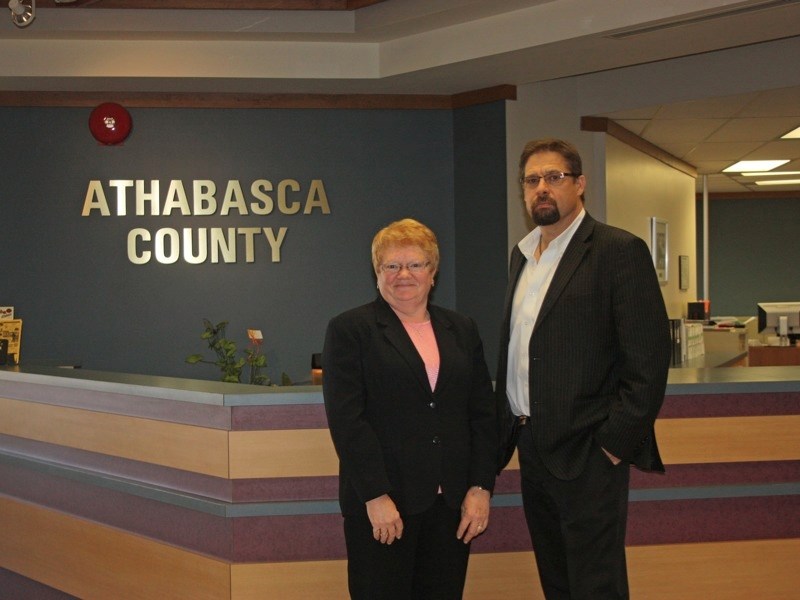One of Athabasca County’s New Year’s resolutions will be to withdraw its membership from the Alberta Energy Corridor (AEC), effective Jan. 1, 2014.
The decision comes after an extensive presentation from AEC executive director Angela Betts and AEC Board of Directors chairman Cal Gayowski on a “New Alberta Energy Corridor” geared towards regionalizing economic development throughout the county, and specifically between Athabasca County, the Town of Athabasca and the Village of Boyle.
“I think their fundamental pitch was they would do all of the tourism-economic development for the town, county and village, and so council declined that offer,” said Athabasca County manager Gary Buchanan.
County council rejected the AEC’s proposal, which included a request for $175,000 over the next year from the county, in part because the county will already be funding its tourism and economic development committee for the same amount, according to two county councillors.
The AEC is a government- and industry-funded agency concerned with economic development of the Athabasca, Boyle and Wandering River areas.
The Village of Boyle is still a member of the AEC, but the Town of Athabasca passed a motion at its Dec. 4, 2012 council meeting to “not renew any further funding for the Alberta Energy Corridor,” which had amounted to $30,000 annually for the three years prior.
During the AEC presentation to county council last Tuesday, Gayowski said Northwest Fabricators, which he owns, is looking for qualified tradespeople all the time, and the company has some of the highest-paying jobs in the industry.
“This is a great place to live. Our employee retention has been very good,” said Gayowski. “We don’t have people leaving once they get a sense of small town Alberta.”
Betts said Tuesday the AEC has many partners including Athabasca County, the Village of Boyle and numerous industry players; however, “we are not satisfied,” Betts told council at the AEC presentation, seeking further support.
“In the pursuit of maximizing profit and growth for its partners, the AEC requires increased participation and investment from both its existing partners as well as a broader reach generated by recruitment of new partners,” Betts told council.
“It’s hard to forge forward, but that’s what you have to do to make things happen,” Athabasca County Reeve Doris Splane told the AEC delegates.
“We’re not working in a silo,” said Betts. “We’re just running on three tires.”
Despite the AEC’s thorough presentation and appeal to county council for continued support, some councillors were unimpressed by the viability and value of AEC membership and said so.
“Here we are in year four, year five, and we still don’t have anything to show for it,” said Athabasca County councillor Kevin Haines.
Gayowski said it costs money to spur economic development in the region. Betts asked the county for $175,000 and said it was shortsighted of the AEC to have originally pitched a two-year commitment to the county when economic development is an indefinite future investment.
“There’s nothing tangible. Show me something tangible,” said Haines. “I know (the AEC has) met with industry; I know they have met with different businesses … but to date, there’s nothing tangible for the county’s commitment over the last several years,” said Haines.
“This is kind of shocking. It’s going to have to be chewed on for a while,” said councillor Jack Dowhaluk after the AEC’s presentation to council.
“I think we have to work together, totally. I don’t think we can leave even one of these partners out,” he said.
However, council still went on to terminate membership in the AEC.
“Following their discussion, council voted to decline your proposal to have Alberta Energy Corridor act as the economic development entity for the county,” said Splane in a Dec. 12 letter informing Gayowski of council’s new direction.
“In addition, council voted to terminate the county’s membership in the Alberta Energy Corridor, effective January 1, 2014. Though council is withdrawing from formal membership in AEC at this time, council is open to working with AEC on mutually beneficial projects in the future,” according to the reeve.
Betts declined to comment on the county withdrawing its membership, but did say, “The AEC board will be determining our strategy for moving forward at our January meeting.”
Athabasca County councillor David Yurdiga, also the AEC board’s vice-chair, said the AEC’s proposal was rejected largely because $175,000 to regionalize economic development would cannibalize Athabasca County’s tourism and economic development (TED) committee.
“We couldn’t take all the money from TED, because it fills another role,” said Yurdiga.
The aim of the “New AEC,” according to Betts at the presentation, would be to maintain the current business and industrial climate and encourage sustainable growth by ensuring “infrastructure meets industry and community needs,” and to “plan and facilitate economic development and tourism initiatives” on the regional level.
“The way the presentation looked, it looked like the AEC wanted to take over the role of TED and provide a regional (role),” said Yurdiga. “The two can’t exist at the same level.”
Haines shared the view that by continuing to support the AEC by bankrolling $175,000 over the next year, the county would be cannibalizing TED’s mandate.
“The $175,000 that (the AEC is) requesting is more or less the budget that TED will be working on,” said Haines. “If we’re into year four, and we have nothing tangible, and that’s a sizable contribution on our part … maybe there’s other directions that we could be going with this money.”
Since Jodie Pruden left her position as the county’s TED officer earlier this year, the position has remained vacant, but Yurdiga hopes it will be filled in the near future.
“If the county decides to opt out of AEC at this point, it doesn’t mean that (AEC) has to shut down. I mean, it’s really not that much money; if industry decides that it’s important for its economic well-being, then all they have to do is step up and carry on,” said Haines.


